Review on the Life Cycle Assessment of Thermal Energy Storage Used in Building Applications
Abstract
1. Introduction
1.1. Life Cycle Assessment (LCA)
- ISO 14040: “LCA principles and framework”
- ISO 14044: “LCA requirements and guidelines”
- Cradle-to-grave: a full assessment of a product throughout its entire life cycle (acquisition of raw material, manufacturing/production, utilization, and disposal).
- Cradle-to-gate: a partial assessment of the product from raw material acquisition to manufacturing/production. This scope ends at the factory fence (i.e., excluding distributions to the users).
- Gate-to-gate: a partial assessment of the product life cycle, focusing on only one process in the overall manufacturing/production, usually within the factory fence.
- Gate-to-grave: a partial assessment of the product life cycle, which includes the distribution to users, the utilization phase, and disposal.
- Cradle-to-cradle: this evaluation adopts a circular economy perspective, where the disposal of the product is recycled back to the input and closes the loop.
1.2. Life Cycle Sustainability Assessment (LCSA)
- LCSA provides a structured form that allows practitioners to unify complex environmental, economic, and social information and data.
- LCSA provides a more inclusive picture by examining the trade-offs between the three sustainability pillars along the product or technology life cycle.
- LCSA assists decision-makers in selecting sustainable products or technologies.
2. Literature of LCA/LCSA of TES for Building Applications
3. LCA Methodology for TES with Low TRL
- Comparability: challenging to make a direct comparison with established technology because emerging technologies have undefined, changing, and inequivalent functions and a different system boundary.
- Data: insufficient or inaccessible inventory data and inadequate data quality.
- Scale-up concerns: different processes, equipment, and efficiency at the lab and commercial scale.
- Uncertainty: the study integrity may be compromised by inherent variability in the LCA method, leading to inaccurate technology development and decision-making.
- Assessment time: LCA takes time, and evaluation time is crucial for advancing technology.
- Conducting an LCA study at the initial design phase has the potential to direct emerging technology development for achieving a better environmental performance by recognizing hotspots and making a comparison with existing technology [56].
- Decisions taken during the initial development phase have extensive future impacts on functionality, cost, and environmental effects for emerging technologies [58]. Therefore, LCA can be used at this early stage to recognize the consequences of these decisions, which may avoid preventable environmental problems and foresee environmental regulation changes [57].
- LCA study, along with techno-economic analysis, are often requested by funding agencies (such as the US Department of Energy) for any proposed projects, including the early stages of technology research [56].
- Considering that the only LCA study of TCES at a system level was published 19 years ago, more LCA studies of TCES at a system level will be useful to capture the recent improvement in TCES for building applications and to confirm the positive environmental impact. GHG emission reductions from the building sector are one of the main reasons for TCES technology development.
4. Conclusions
Author Contributions
Funding
Data Availability Statement
Acknowledgments
Conflicts of Interest
Nomenclature
| ATES | Aquifer thermal energy storage |
| CED | Cummulative energy demand |
| CPHES | Conventional pumped hydro energy storage |
| BTES | Borehole thermal energy storage |
| CSP | Concentrated Solar Plant |
| GHG | Greenhouse Gasses |
| GWP | Global Warming Potential |
| IEA | International Energy Agency |
| IPCC | International Panel on Climate Change |
| ISO | International Organization of Standardization |
| LCA | Life cycle assessment |
| LCC | Life cycle costing |
| LCI | Life cycle inventory analysis |
| LCIA | Life cycle impact assessment |
| LCSA | Life cycle sustainability assessment |
| MVAT | Multi-attribute value theory |
| n.m. | Not mentioned |
| PCM | Phase Change Material |
| PENR | Primary Energy Non-Renewable Resource |
| SETAC | Society of Environmental Toxicology and Chemistry |
| SLCA | Social life cycle assessment |
| STES | Seasonal Thermal Energy Storage |
| TCES | Thermochemical Energy Storage |
| TCM | Thermochemical Materials |
| TES | Thermal Energy Storage |
| TRL | Technology Readiness Level |
| UNEP | United Nations Environment Programme |
| UPHES | Underground pumped hydro energy storage |
References
- United Nations Environment Programme (UNEP). 2021 Global Status Report for Buildings and Construction: Towards a Zero-emission, Efficiend and Resilient Buildings and Construction Sector. Available online: https://globalabc.org/sites/default/files/2021-10/GABC_Buildings-GSR-2021_BOOK.pdf (accessed on 19 December 2022).
- United Nations Environment Programme (UNEP). Global Roadmap Towards Low-GHG and Resilient Buildings. Available online: https://globalabc.org/resources/publications/global-roadmap-towards-low-ghg-and-resilient-buildings (accessed on 1 November 2022).
- N’Tsoukpoe, K.E.; Osterland, T.; Opel, O.; Wolfgang, K.L.R. Cascade thermochemical storage with internal condensation heat recovery for better energy and exergy efficiencies. Appl. Energy 2016, 181, 562–574. [Google Scholar] [CrossRef]
- Mabrouk, R.; Naji, H.; Benim, A.C.; Dhahri, H. A state of the art review on sensible and latent heat thermal energy storage processes in porous media: Mesoscopic Simulation. Appl. Sci. 2022, 12, 6995. [Google Scholar] [CrossRef]
- Farid, M.; Auckaili, A.; Gholamibozanjani, G. Energy-saving, peak load shifting and price-based control heating and cooling. In Thermal Energy Storage with Phase Change Materials, 1st ed.; Farid, M., Auckaili, A., Gholamibozanjani, G., Eds.; CRC Press: Boca Raton, FL, USA, 2021. [Google Scholar] [CrossRef]
- Gholamibozanjani, G.; Farid, M. A Critical Review on the Control Strategies Applied to PCM-Enhanced Buildings. Energies 2021, 14, 1929. [Google Scholar] [CrossRef]
- Schmerse, E.; Ikutegbe, C.A.; Auckaili, A.; Farid, M.M. Using PCM in Two Proposed Residential Buildings in Christchurch, New Zealand. Energies 2020, 13, 6025. [Google Scholar] [CrossRef]
- Abedin, A.H.; Rosen, M.A. A critical review of thermochemical energy storage systems. Open Renew. Energy J. 2011, 4, 42–46. [Google Scholar] [CrossRef]
- Laurie, A.; Abanades, S. Recent Advances in Thermochemical Energy Storage via Solid-Gas Reversible Reactions at High Temperature. Energies 2020, 13, 5859. [Google Scholar] [CrossRef]
- Clark, R.; Mehrabadi, A.; Farid, M. State of the art on salt hydrate thermochemical energy storage systems for use in building applications. J. Energy Storage 2020, 27, 101145. [Google Scholar] [CrossRef]
- Ding, Y.; Riffat, S.B. Thermochemical energy storage technologies for building applications: A state-of-the-art review. Int. J. Low-Carbon Technol. 2013, 8, 106–116. [Google Scholar] [CrossRef]
- Nienborg, B.; Gschwander, S.; Munz, G.; Fröhlich, D.; Helling, T.; Horn, R.; Weinläder, H.; Klinker, F.; Schossig, P. Life cycle assessment of thermal energy storage materials and components. Energy Procedia 2018, 155, 111–120. [Google Scholar] [CrossRef]
- Kloepffer, W. Life cycle sustainability assessment of products. Int. J. Life Cycle Assess. 2008, 13, 89–95. [Google Scholar] [CrossRef]
- Guinée, J. Life Cycle Sustainability Assessment: What Is It and What Are Its Challenges? In Taking Stock of Industrial Ecology; Clift, R., Druckman, A., Eds.; Springer: Cham, Switzerland, 2016; pp. 45–68. [Google Scholar] [CrossRef]
- Society of Environmental Toxicology and Chemistry (SETAC). Guidelines for Life-Cycle Assessment: A “Code of Practice” (Edition 1). Available online: https://cdn.ymaws.com/www.setac.org/resource/resmgr/books/lca_archive/guidelines_for_life_cycle.pdf (accessed on 1 November 2022).
- ISO 14040; Environmental Management—Life Cycle Assessment—Principles and Framework. International Organization for Standardization (ISO): Geneva, Switzerland, 2006.
- Mälkki, H.; Alanne, K. An overview of life cycle assessment (LCA) and research-based teaching in renewable and sustainable energy education. Renew. Sustain. Energy Rev. 2017, 69, 218–231. [Google Scholar] [CrossRef]
- Milovanoff, A.; Prado, V. Institution of Chemical Engineers (IChemE). Life Cycle Assessment (LCA) for Chemical Engineers Presentation Slides. 2022. Available online: https://www.icheme.org/career/training/on-demand-online-courses/life-cycle-assessment-lca-for-chemical-engineers/ (accessed on 16 August 2022).
- Li, T.; Roskilly, A.P.; Wang, Y. Life cycle sustainability assessment of grid-connected photovoltaic power generation: A case study of Northeast England. Appl. Energy 2018, 227, 465–479. [Google Scholar] [CrossRef]
- Cao, C. Sustainability and life assessment of high strength natural fibre composites in construction. In Advanced High Strength Natural Fibre Composites in Construction; Fan, M., Fu, F., Eds.; Elsevier: Amsterdam, The Netherlands, 2017; pp. 529–544. [Google Scholar] [CrossRef]
- Zanni, S.; Awere, E.; Bonoli, A. Life cycle sustainability assessment: An ongoing journey. In Life Cycle Sustainability Assessment for Decision-Making; Ren, Z., Toniolo, S., Eds.; Elsevier: Amsterdam, The Netherlands, 2020; pp. 57–93. [Google Scholar] [CrossRef]
- World Commission on Environment and Development (WCED). Our Common Future. WCED UN. Available online: https://sustainabledevelopment.un.org/content/documents/5987our-common-future.pdf (accessed on 14 January 2022).
- Mensah, J. Sustainable development: Meaning, history, principles, pillars and implications for human action: Literature review. Cogent Soc. Sci. 2019, 5, 1653531. [Google Scholar] [CrossRef]
- Fauzi, R.T.; Lavoie, P.; Sorelli, L.; Heidari, M.D.; Amor, B. Exploring the Current challenges and opportunities of life cycle sustainability assessment. Sustainability 2019, 11, 636. [Google Scholar] [CrossRef]
- Hunkeler, D.; Lichtenvort, K.; Rebitzer, G. Environmental Life Cycle Costing, 1st ed.; CRC Press: Boca Raton, FL, USA, 2008. [Google Scholar] [CrossRef]
- United Nations Environment Programme (UNEP); Society of Environmental Toxicology and Chemistry (SETAC). Towards a Life Cycle Sustainability Assessment: Making Informed Choices on Products. Available online: https://wedocs.unep.org/bitstream/handle/20.500.11822/8001/UNEP_LifecycleInit_Dec_FINAL.pdf?sequence=3&%3BisAllowed= (accessed on 1 November 2022).
- Swarr, T.E.; Hunkeler, D.; Klöpffer, W.; Pesonen, H.-L.; Ciroth, A.; Brent, A.; Pagan, R. Environmental Life-Cycle Costing: A Code of Practice. Int. J. Life Cycle Assess. 2011, 16, 389–391. [Google Scholar] [CrossRef]
- United Nations Environment Programme (UNEP). Guidelines for Social Life Cycle Assessment of Products and Organizations. Available online: https://www.unep.org/resources/report/guidelines-social-life-cycle-assessment-products (accessed on 1 November 2022).
- Visentin, C.; da Silva Trentin, A.W.; Braun, A.B.; Thomé, A. Life cycle sustainability assessment: A systematic literature review through the application perspective, indicators, and methodologies. J. Clean. Prod. 2020, 270, 122509. [Google Scholar] [CrossRef]
- Tatsidjodoung, P.; Le Pierrès, N.; Luo, L. A review of potential materials for thermal energy storage in building applications. Renew. Sustain. Energy Rev. 2013, 18, 327–349. [Google Scholar] [CrossRef]
- Colclough, S.; McGrath, T. Net energy analysis of a solar combi system with Seasonal Thermal Energy Store. Appl. Energy 2015, 147, 611–616. [Google Scholar] [CrossRef]
- Bahlawan, H.; Morini, M.; Pinelli, M.; Poganietz, W.-R.; Spina, P.R.; Venturini, M. Optimization of a hybrid energy plant by integrating the cumulative energy demand. Appl. Energy 2019, 253, 113484. [Google Scholar] [CrossRef]
- Karasu, H.; Dincer, I. Life cycle assessment of integrated thermal energy storage systems in buildings: A case study in Canada. Energy Build. 2020, 217, 109940. [Google Scholar] [CrossRef]
- Stemmle, R.; Blum, P.; Schüppler, S.; Fleuchaus, P.; Limoges, M.; Bayer, P.; Menberg, K. Environmental impacts of aquifer thermal energy storage (ATES). Renew. Sustain. Energy Rev. 2021, 151, 111560. [Google Scholar] [CrossRef]
- Algieri, A.; Beraldi, P.; Pagnotta, G.; Spadafora, I. The optimal design, synthesis and operation of polygeneration energy systems: Balancing life cycle environmental and economic priorities. Energy Convers. Manag. 2021, 243, 114354. [Google Scholar] [CrossRef]
- Toosi, H.A.; Lavagna, M.; Leonforte, F.; Del Pero, C.; Aste, N. Building decarbonization: Assessing the potential of building-integrated photovoltaics and thermal energy storage. Energy Rep. 2022, 8, 574–581. [Google Scholar] [CrossRef]
- David, B.R.; Spencer, S.; Miller, J.; Almahmoud, S.; Jouhara, H. Comparative environmental life cycle assessment of conventional storage system and innovative thermal energy storage system. Int. J. Thermofluids 2021, 12, 100116. [Google Scholar] [CrossRef]
- Tevis, R.; Schuster, N.; Evans, F.; Himmler, R.; Gheewala, S.H. A multi-scenario life cycle impact comparison of operational energy supply techniques for an office building in Thailand. Energy Build. 2019, 190, 172–182. [Google Scholar] [CrossRef]
- Castell, A.; Menoufi, K.; de Gracia, A.; Rincón, L.; Boer, D.; Cabeza, L.F. Life Cycle Assessment of alveolar brick construction incorporating phase change materials (PCMs). Appl. Energy 2013, 101, 600–608. [Google Scholar] [CrossRef]
- Sobolčiak, P.; Abdelrazeq, H.; Özerkan, N.G.; Ouederni, M.; Nógellová, Z.; AlMaadeed, M.A.; Karkri, M.; Krupa, I. Heat transfer performance of paraffin wax based phase change materials applicable in building industry. Appl. Therm. Eng. 2016, 107, 1313–1323. [Google Scholar] [CrossRef]
- Boer, D.; Segarra, M.; Fernández, A.I.; Vallès, M.; Mateu, C.; Cabeza, L.F. Approach for the analysis of TES technologies aiming towards a circular economy: Case study of building-like cubicles. Renew. Energy 2019, 150, 589–597. [Google Scholar] [CrossRef]
- Bonamente, E.; Aquino, A. Environmental performance of innovative ground-source heat pumps with PCM energy storage. Energies 2019, 13, 117. [Google Scholar] [CrossRef]
- Di Bari, R.; Horn, R.; Nienborg, B.; Klinker, F.; Kieseritzky, E.; Pawelz, F. The environmental potential of phase change materials in building applications. A multiple case investigation based on life cycle assessment and building simulation. Energies 2020, 13, 3045. [Google Scholar] [CrossRef]
- Nöel, J.A.; Allred, p.M.; White, M.A. Life cycle assessment of two biologically produced phase change materials and their related products. Int. J. Life Cycle Assess. 2015, 20, 367–376. [Google Scholar] [CrossRef]
- Menoufi, K.; Castell, A.; Farid, M.M.; Boer, D.; Cabeza, L.F. Life cycle assessment of experimental cubicles including PCM manufactured from natural resources (esters): A theoretical study. Renew. Energy 2013, 51, 398–403. [Google Scholar] [CrossRef]
- Nienborg, B.; Helling, T.; Fröhlich, D.; Horn, G.; Schossig, P. Closed adsorption heat storage—A life cycle assessment on material and component levels. Energies 2018, 11, 3421. [Google Scholar] [CrossRef]
- Horn, R.; Burr, M.; Fröhlich, D.; Gschwander, S.; Held, M.; Lindner, J.P.; Munz, G.; Nienborg, B.; Schossig, P. Life cycle assessment of innovative materials for thermal energy storage in buildings. Procedia CIRP 2018, 69, 206–211. [Google Scholar] [CrossRef]
- Masruroh, N.A.; Li, B.; Klemeš, J. Life cycle analysis of a solar thermal system with thermochemical storage process. Comput.-Aided Chem. Eng. 2003, 14, 221–226. [Google Scholar] [CrossRef]
- Masruroh, N.A.; Li, B.; Klemeš, J. Life cycle analysis of a solar thermal system with thermochemical storage process. Renew. Energy 2006, 31, 537–548. [Google Scholar] [CrossRef]
- Naves, A.X.; Barreneche, C.; Fernandez, A.I.; Cabeza, L.F.; Haddad, A.N.; Boer, D. Life cycle costing as a bottom line for the life cycle sustainability assessment in the solar energy sector: A review. Sol. Energy 2019, 192, 238–262. [Google Scholar] [CrossRef]
- Toosi, H.A.; Lavagna, M.; Leonforte, F.; Del Pero, C.; Aste, N. A novel LCSA-Machine learning based optimization model for sustainable building design-A case study of energy storage system. Build. Environ. 2022, 20, 108656. [Google Scholar] [CrossRef]
- Guo, Z.; Ge, S.; Yao, X.; Li, H.; Li, X. Life cycle sustainability assessment of pumped hydro energy storage. Int. J. Energy Res. 2020, 22, 192–204. [Google Scholar] [CrossRef]
- International Energy Agency (IEA). Energy Technology Perspectives. 2020. Available online: https://iea.blob.core.windows.net/assets/04dc5d08-4e45-447d-a0c1-d76b5ac43987/Energy_Technology_Perspectives_2020_-_Special_Report_on_Clean_Energy_Innovation.pdf (accessed on 1 November 2022).
- International Energy Agency (IEA). ETP Clean Energy Technology Guide. 2022. Available online: https://www.iea.org/data-and-statistics/data-tools/etp-clean-energy-technology-guide (accessed on 1 November 2022).
- Sénéchal, T.; Talon, O. Use of LCA for Accompanying Innovation Processes All Along the TRL Scale [Paper Presentation]. Available online: https://www.researchgate.net/publication/310342960_USE_OF_LCA_FOR_ACCOMPANYING_INNOVATION_PROCESSES_ALL_ALONG_THE_TRL_SCALE (accessed on 1 November 2022).
- Moni, S.M.; Mahmud, R.; High, K.; Carbajales-Dale, M. Life cycle assessment of emerging technologies: A review. J. Ind. Ecol. 2020, 24, 52–63. [Google Scholar] [CrossRef]
- Cucurachi, S.; van der Giesen, C.; Guinée, J. Ex-ante LCA of emerging technologies. Procedia CIRP 2018, 69, 463–468. [Google Scholar] [CrossRef]
- Villares, M.; Işıldar, A.; van der Giesen, C.; Guinée, J. Does ex ante application enhance the usefulness of LCA? A case study on an emerging technology for metal recovery from e-waste. Int. J. Life Cycle Assess. 2017, 22, 1618–1633. [Google Scholar] [CrossRef]
- Wender, B.A.; Foley, R.W.; Hottle, T.A.; Sadowski, J.; Prado-Lopez, V.; Eisenberg, D.A.; Laurin, L.; Seager, T.P. Anticipatory life-cycle assessment for responsible research and innovation. J. Responsible Innov. 2014, 1, 200–207. [Google Scholar] [CrossRef]
- Piccinno, F.; Hischier, R.; Seeger, S.; Som, C. From laboratory to industrial scale: A scale-up framework for chemical processes in life cycle assessment studies. J. Clean. Prod. 2016, 135, 1085–1097. [Google Scholar] [CrossRef]
- Comodi, G.; Bevilacqua, M.; Caresana, F.; Pelagalli, L.; Venella, P.; Paciarotti, C. LCA analysis of renewable domestic hot water systems with unglazed and glazed solar thermal panels. Energy Procedia 2014, 61, 234–237. [Google Scholar] [CrossRef]
- Moore, A.D.; Urmee, T.; Bahri, P.A.; Rezvani, S.; Baverstock, G.F. Life cycle assessment of domestic hot water systems in Australia. Renew. Energy 2017, 103, 187–196. [Google Scholar] [CrossRef]

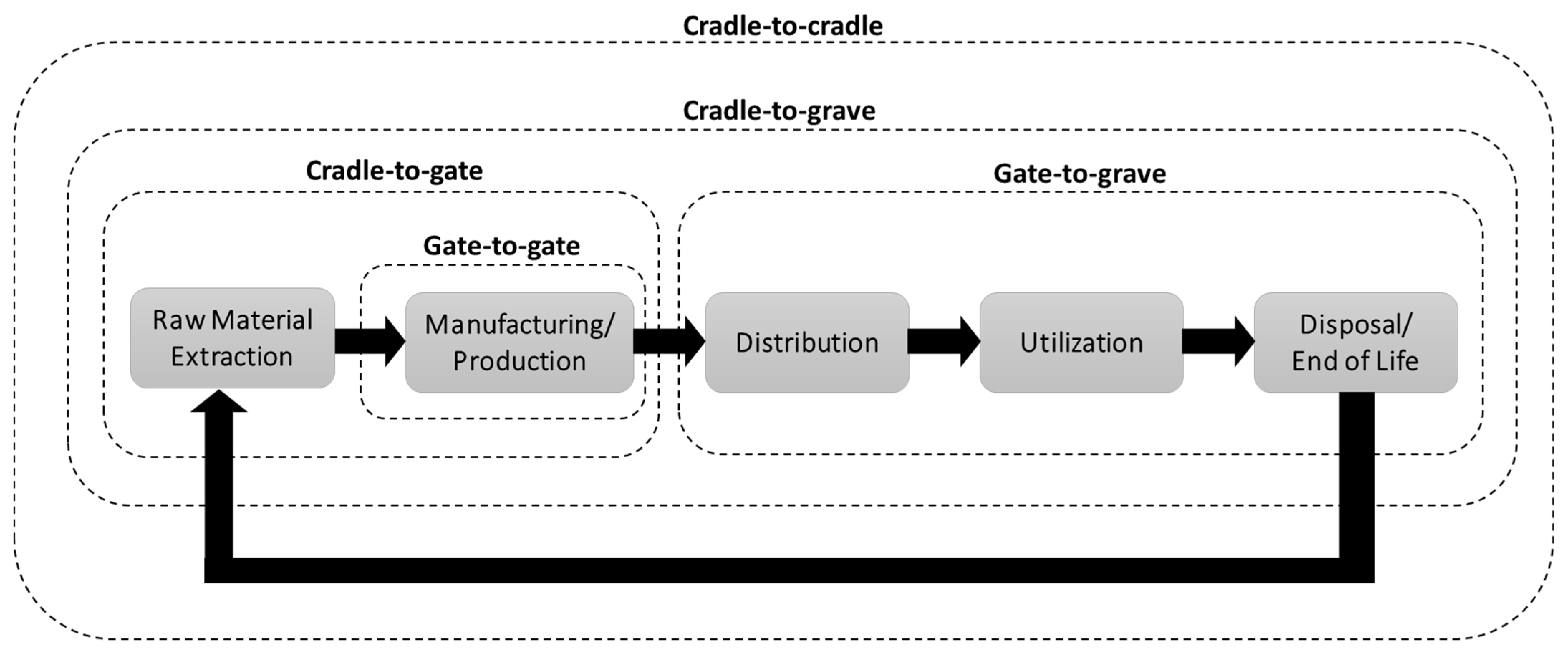
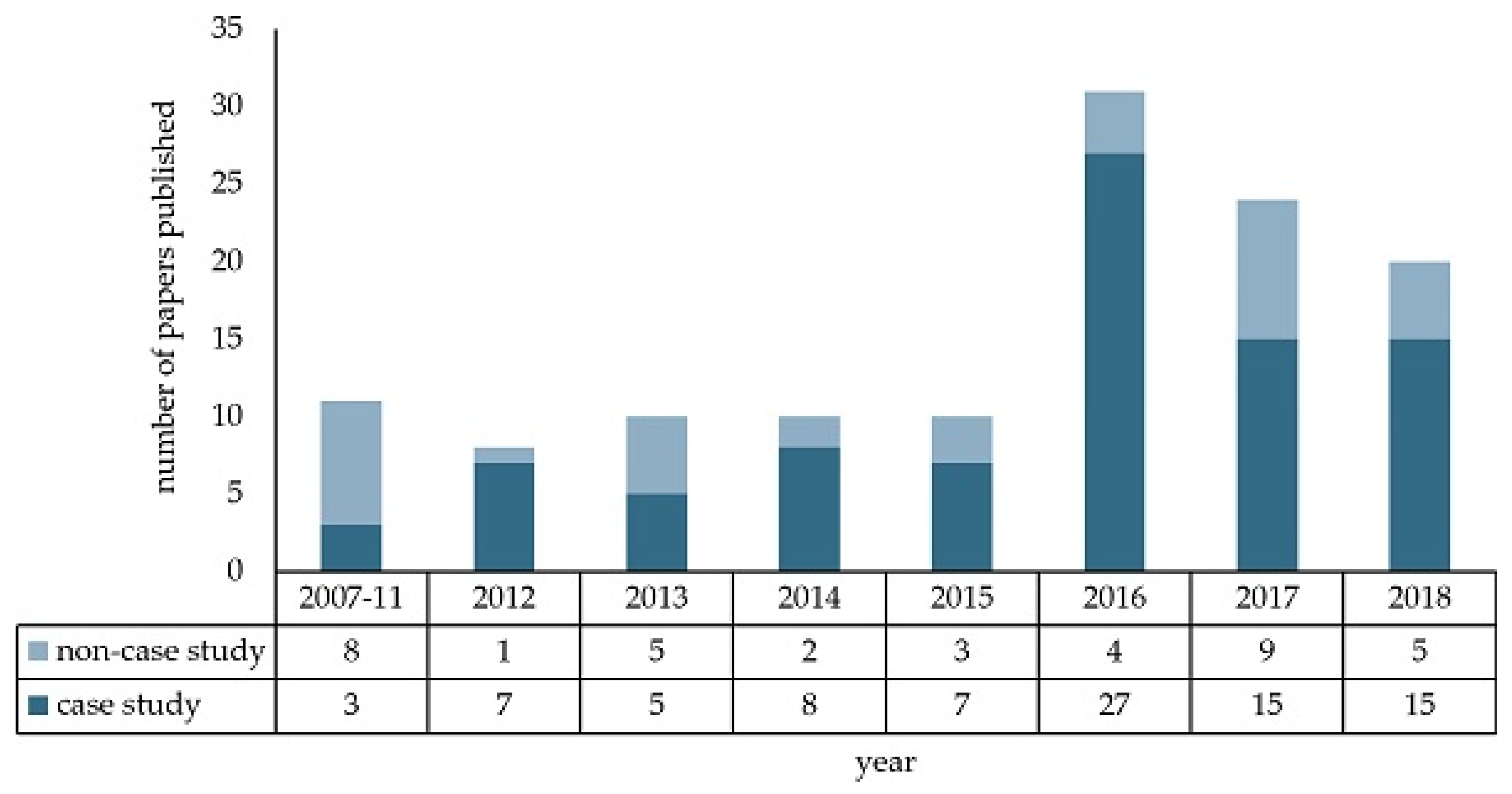

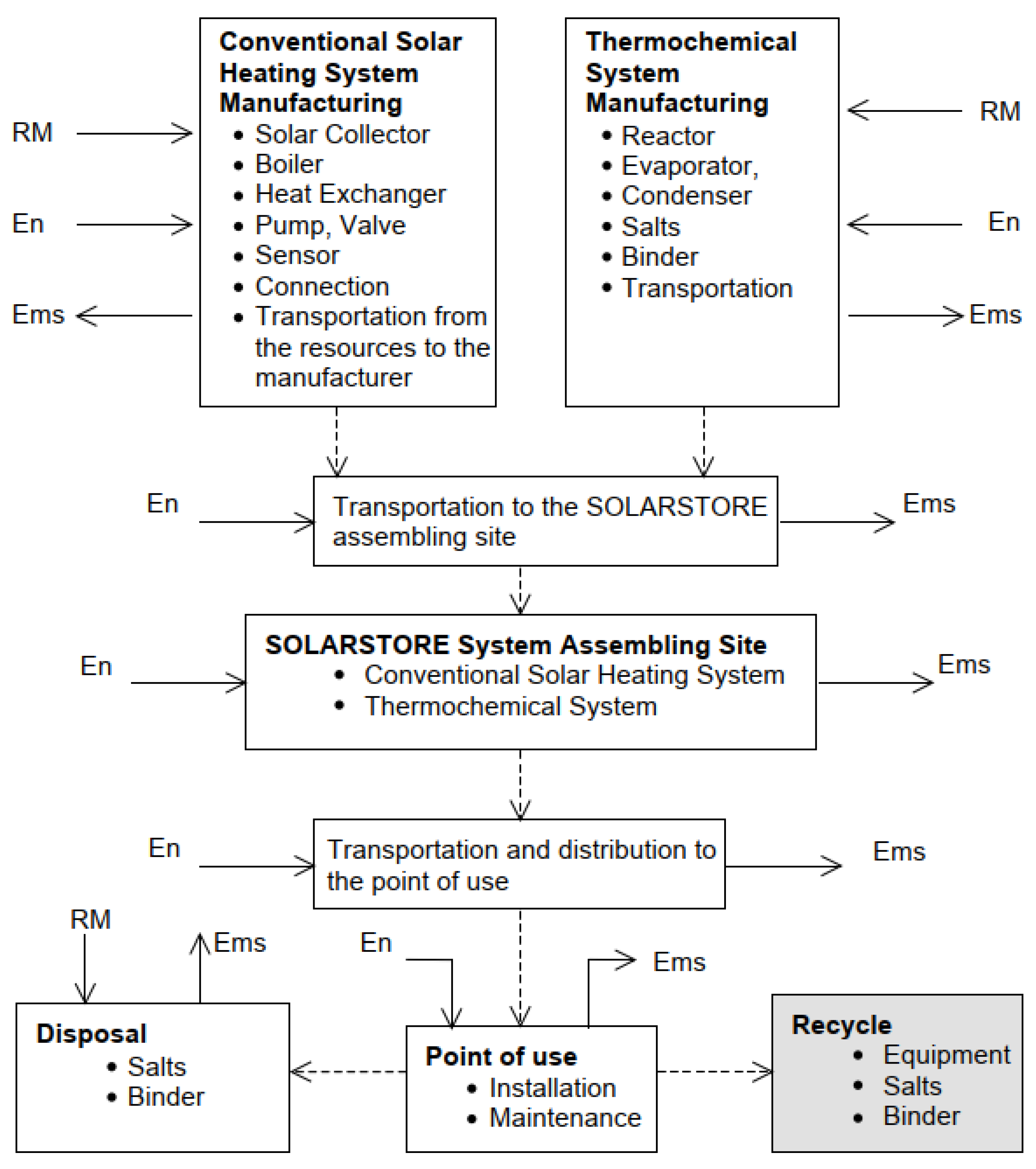

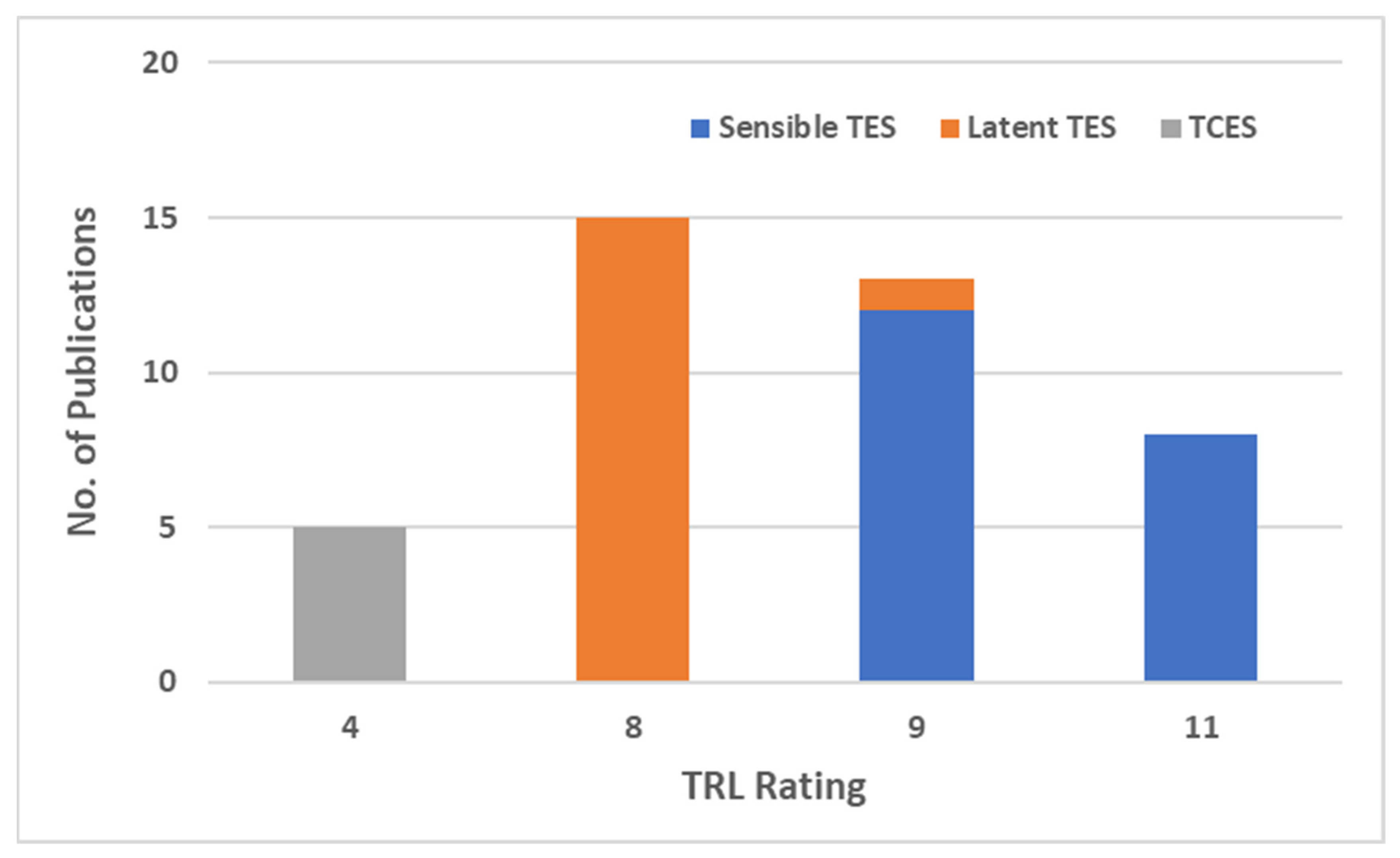
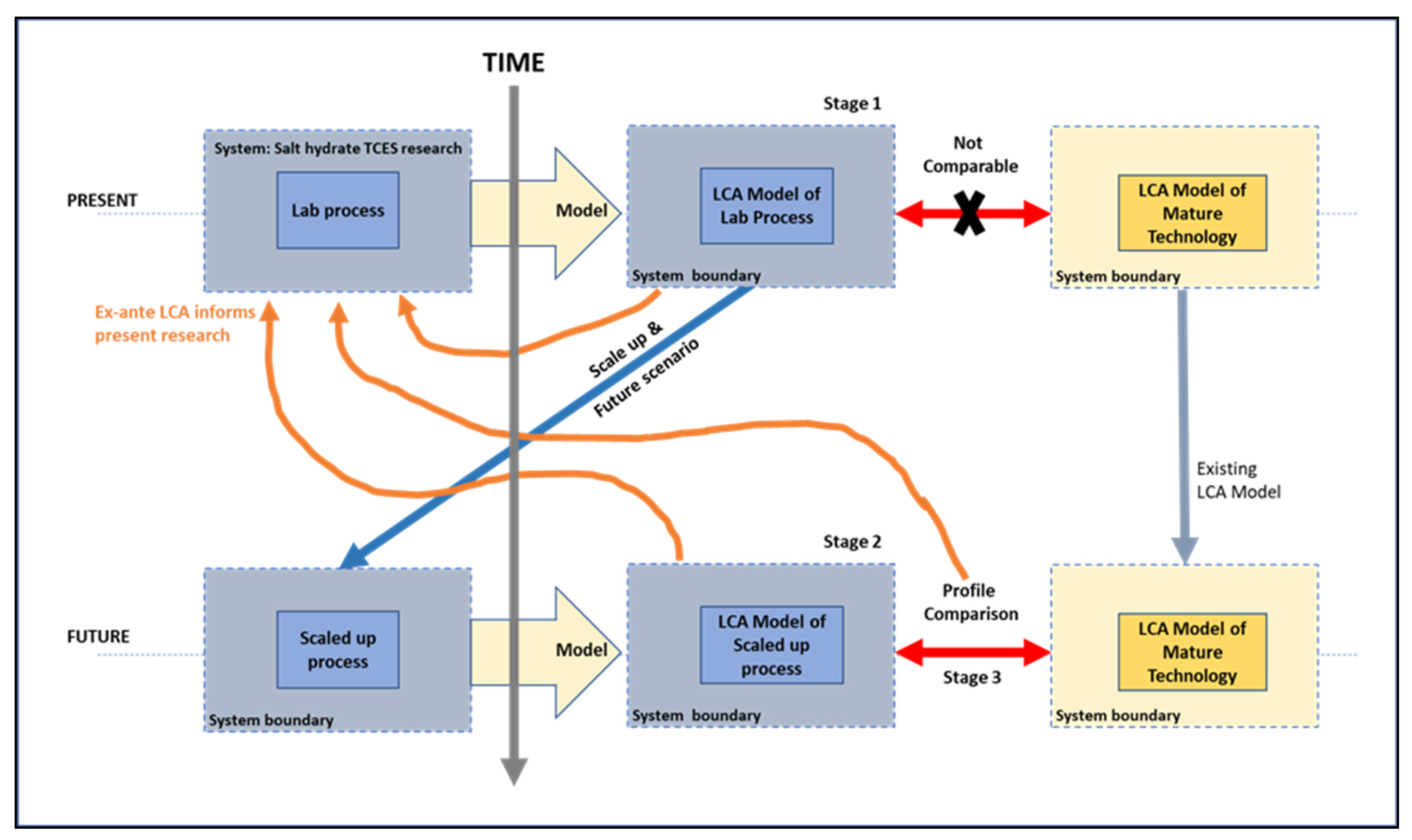

| LCA Database | Description |
|---|---|
| US NREL LCI Database | US Data |
| ELCD database | Europe data |
| JLCA database | Japanese data |
| The Evah OzLCI2019 | Australia data |
| Ecoinvent | Global data |
| Global LCA Data Access | Global Data |
| LCA Software | Developer |
|---|---|
| Athena | Athena Institute (Sinking Spring, PA, USA) |
| BEES | National Institute of Standards and Technology (Gaithersburg, MD, USA) |
| CMLCA | Institute of Environmental Science (CML) (Leiden, The Netherlands) |
| GaBi | Sphera (Chicago, IL, USA) |
| SimaPro | Pre Consultants (Amersfoort, The Netherlands) |
| Umberto | Institute for Environmental Informatics (Hamburg, Germany) |
| OpenLCA | GreenDelta GmbH (Berlin, Germany) |
| OneClickLCA | One Click LCA Ltd. (Helsinki, Finland) |
| Keywords | Result |
|---|---|
| (“Life cycle assessment” OR “life cycle analysis” OR LCA) AND (“thermal energy storage” OR “thermochemical energy storage” OR “thermochemical storage” OR “sorption storage”) | 106 publications |
| (“Life cycle sustainability assessment” OR “Life cycle sustainability analysis” OR LCSA) AND (“thermal energy storage” OR “thermochemical energy storage” OR “thermochemical storage” OR “sorption storage”) | 1 publication |
| (“Life cycle sustainability assessment” OR “Life cycle sustainability analysis” OR LCSA) AND (“thermal energy storage” OR “thermochemical energy storage” OR “thermochemical storage” OR “sorption storage” OR “energy storage” OR “heat storage”) | 4 publications |
| TES Type | TES Description | LCA Software/Method | LCA Database | Main Findings | Ref. |
|---|---|---|---|---|---|
| Sensible | Water tank Seasonal Thermal Energy Storage (STES) | SimaPro/IPCC GWP 2007 100a, CED | Ecoinvent, ELCD |
| [31] |
| Sensible | Water tank | OpenLCA/CED | Ecoinvent |
| [32] |
| Sensible | Borehole seasonal (long-term) TES | SimaPro 7.3 | Ecoinvent |
| [33] |
| Sensible | Aquifer Thermal Energy Storage (ATES) | SimaPro 9.0.0.35/IMPACT 2002+ V2.10 | Ecoinvent 3.5 |
| [34] |
| Sensible | Water tank | n.m. | n.m. |
| [35] |
| Sensible | Water tank | n.m. | Ecoinvent v3.8 |
| [36] |
| Latent | Macroencapsulated PCM (salt hydrate SP-25 A8) | Eco-Indicator 99 (EI99) | Ecoinvent 2009 |
| [39] |
| Latent | PCM in brick walls | GaBi | Ecoinvent |
| [40] |
| Latent | Organic PCMs | n.m. | n.m. |
| [44] |
| Latent | PCM-Underground TES | SimaPRo v9.0.0/CML-IA, ReCiPe 2016 | Ecoinvent v.3.5 |
| [42] |
| Latent | PCM integrated into building-like cubicles | n.m. | Ecoinvent, CES Selector 2018 |
| [41] |
| Latent/Sensible | Thermal battery (steam/water) | OpenLCA 1.10.3 | ELCD 3.2 database |
| [37] |
| Latent | PCM energy storage (heating & cooling) | GaBi v8 | n.m. |
| [43] |
| Latent | Ice storage | SimaPro 8 | Ecoinvent 3 |
| [38] |
| Latent | PCM (Parrafin, Salt Hydrate) | GaBi | n.m. |
| [12] |
| Thermochemical | Solid sorption (Silica gel, zeolites, Metal-Organic Frameworks (MOFs)) | ||||
| Latent | PCM (Parrafin, Salt Hydrate) | n.m. | n.m. |
| [47] |
| Thermochemical | zeolite, silica gel, MOFs, salt hydrate, and salt solution | ||||
| Thermochemical | SOLARSTORE (Salt Hydrate) | n.m. | n.m. |
| [48,49] |
| Thermochemical | Silica gel, SAPO-34, Zeolite 13X, CAU-10-H, Aluminum-Fumarate, LiCl/Vermiculite | GaBi | n.m. |
| [46] |
| Economic Indicators | Environmental Indicators | Social Indicators |
|---|---|---|
| Levelized cost of electricity (LCOE) Levelized cost of storage (LCOS) Payback time | Global warming potential Acidification potential Eutrophication potential Photochemical ozone creation potential Human toxicity potential | Employment Availability factor Contribution to peak dependence on fossil fuel Potential of CHPES and UPHES |
| Technology | TRL Rating |
|---|---|
| Active latent heat storage | 4 |
| Thermochemical storage | 4 |
| Shape-stabilized phase change material (ss-PCM) | 4 |
| Latent (PCM)—Solid−liquid low-temperature heat | 8 |
| Latent (PCM)—Solid−liquid high-temperature heat | 8 |
| Latent (PCM)—Solid−liquid salt hydrates and paraffin | 8 |
| Latent (PCM)—Solid−liquid fatty acids | 8 |
| Latent (PCM)—Solid−liquid sugar alcohols | 8 |
| Latent (PCM)—Solid−liquid salt | 8 |
| Latent (PCM)—Liquid−gaseous | 8 |
| Latent (PCM)—Solid−solid | 8 |
| Sensible—Vacuum-insulated high-temperature water tank | 8 |
| Combined latent and sensible storage system | 8 |
| Latent (PCM)—Solid−liquid ice storage | 9 |
| Latent (PCM)—Solid−liquid aqueous salt solution | 9 |
| Sensible—Chilled water storage | 9 |
| Underground thermal storage—Aquifer thermal energy storage (ATES) | 9 |
| Underground thermal storage—Borehole thermal energy storage (BTES) | 9 |
| Sensible—Hot water tank | 11 |
Disclaimer/Publisher’s Note: The statements, opinions and data contained in all publications are solely those of the individual author(s) and contributor(s) and not of MDPI and/or the editor(s). MDPI and/or the editor(s) disclaim responsibility for any injury to people or property resulting from any ideas, methods, instructions or products referred to in the content. |
© 2023 by the authors. Licensee MDPI, Basel, Switzerland. This article is an open access article distributed under the terms and conditions of the Creative Commons Attribution (CC BY) license (https://creativecommons.org/licenses/by/4.0/).
Share and Cite
Hayatina, I.; Auckaili, A.; Farid, M. Review on the Life Cycle Assessment of Thermal Energy Storage Used in Building Applications. Energies 2023, 16, 1170. https://doi.org/10.3390/en16031170
Hayatina I, Auckaili A, Farid M. Review on the Life Cycle Assessment of Thermal Energy Storage Used in Building Applications. Energies. 2023; 16(3):1170. https://doi.org/10.3390/en16031170
Chicago/Turabian StyleHayatina, Isye, Amar Auckaili, and Mohammed Farid. 2023. "Review on the Life Cycle Assessment of Thermal Energy Storage Used in Building Applications" Energies 16, no. 3: 1170. https://doi.org/10.3390/en16031170
APA StyleHayatina, I., Auckaili, A., & Farid, M. (2023). Review on the Life Cycle Assessment of Thermal Energy Storage Used in Building Applications. Energies, 16(3), 1170. https://doi.org/10.3390/en16031170








